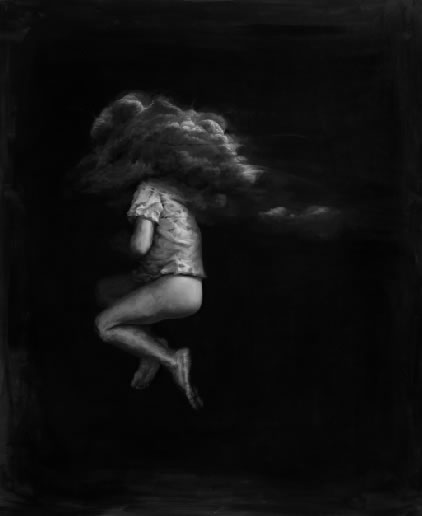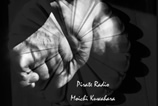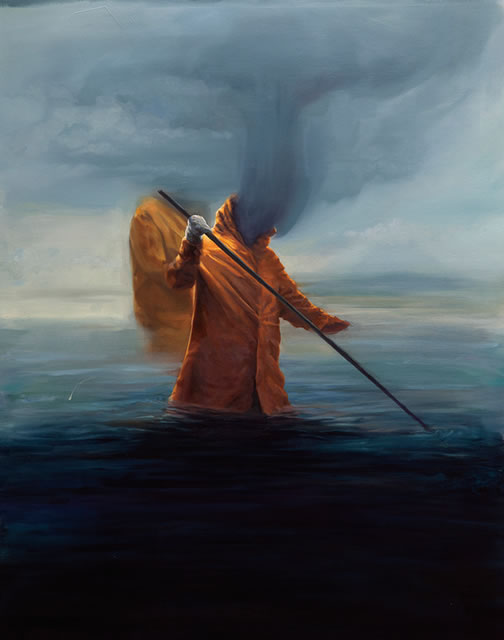
Diego Cirulli ディエゴ・シルリ

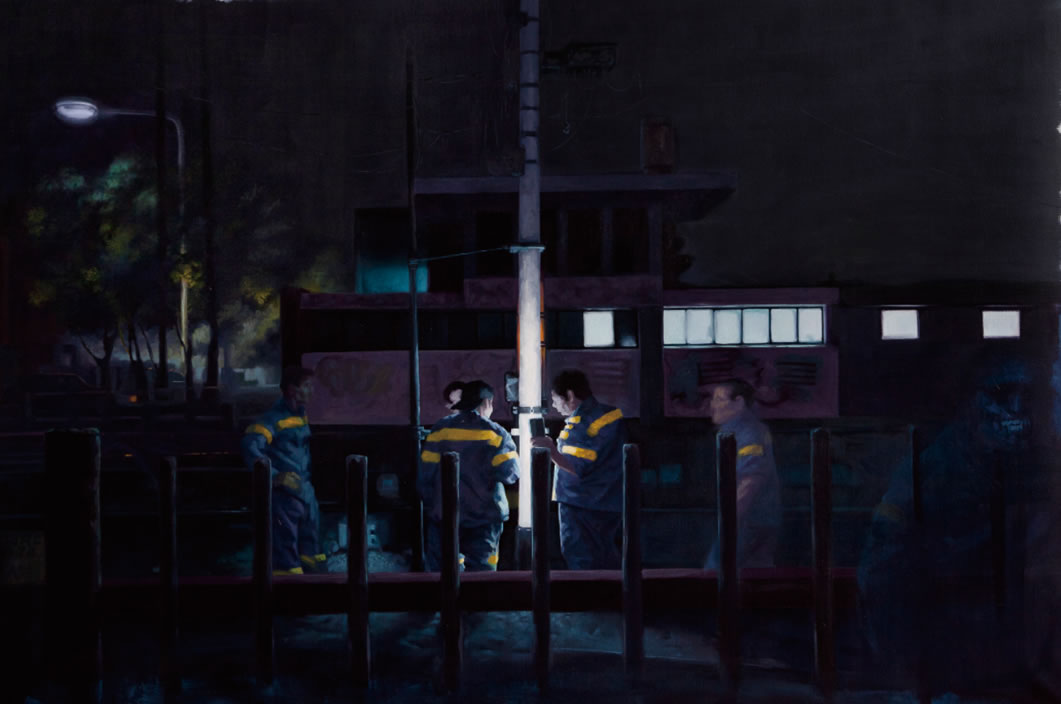
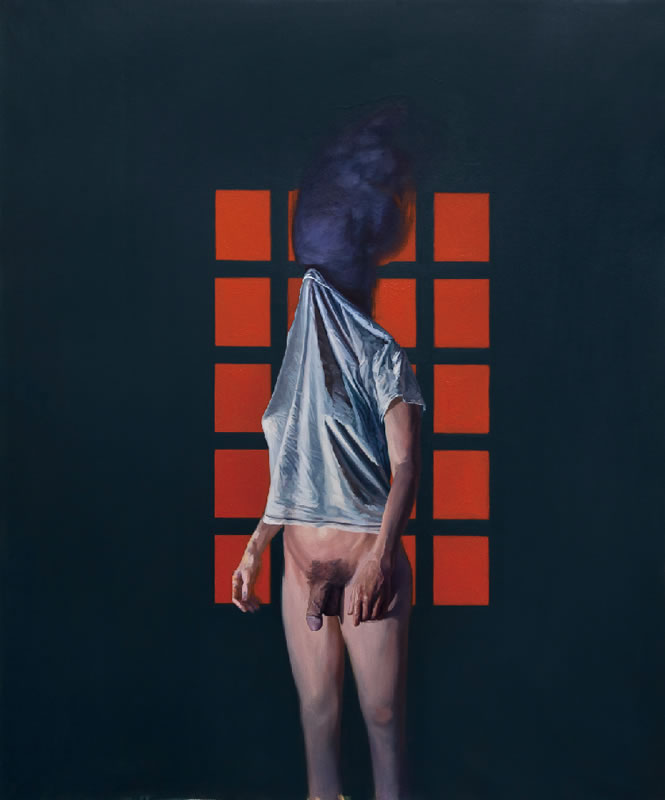
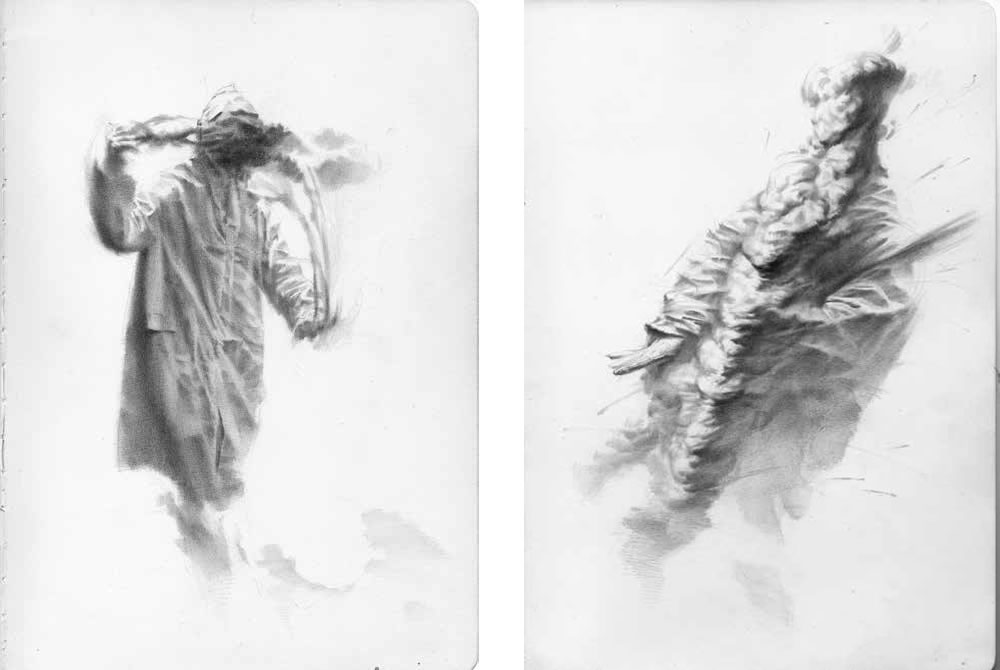
ディエゴ・シルリとの出会い
土屋美葉 Miyo Tsuchiya 104GALERIE キュレーター
初めてディエゴ・シルリの作品を見たのは、去年の6 月、次に控えたベルリン在住のアーティストとの個展の打ち合わせで、ベルリンに行った時のことだった。せっかくなのでギャラリーを見てまわろうと事前にインターネットで情報を集め、いくつか面白そうな展示をピックアップしていた中の展示の一つがBC GalleryでのDiego cirulliの個展、”Hollow”だった。実は、そのピックアップしていた展示の中で期待度は一番高かった。というのは単純に、カバーとして使われていた絵が私好みだったからだ。そしてその勘は間違っていなかった。むしろ予想以上に彼の作品と彼自身のことを知りたくなった。
シルリの絵は古典的、そして比喩的で、リアリティのあるものと、どこかフィクション小説や物語のような少し奇妙でノスタルジックで独創的な不思議な世界を描く。シルリは、アルゼンチン・ブエノスアイレスを拠点に活動しているアーティストで、絵画を中心とした展示を各国で行なっているが、インスタレーションのような要素を比較的多く含んだ展示を多く展開している。また、視覚芸術に加え、同時に舞台芸術の分野でもステージプロデューサーとして活躍している。その経験がシルリから湧出された断続的なイメージをつなぎ合わせ、この不思議な物語を作るのかもしれない。BC Galleryには10点ほどのキャンバスに、オイルで描かれた絵が淡々と並んでいた。そしてキャンバスに囲まれたその空間は静かにゆっくりと私たちをその世界に誘う。
埃の舞う空( から)の建物の中の薄暗い一室が描かれた”Hollow”という作品は、私の中にあるぼんやりとした靄を緩やかに取り除き、外からの音を消し、まるで一人その中に無の状態でいるかのような気分にさせる。目を開けることで自身の存在はまだ認識できるが、目を閉じると心の中だけが存在しているような気分になる。そしてその絵を前に心の中に問いかける。今何を考え、何をすべきか。排除するもの。継続するもの。新しいもの。
赤いバルーンの、”Be Formed”は、この個展の中でも印象的な作品で、個人的に大好きな作品だ。バルーンと人の絶妙な違和感がどこかユーモラスで可愛らしくもあり、だがしっかりとした意志を感じる。希望と生命の持つ強さ。そして新しい命や新しい意思の誕生を彷彿とさせる。この個展のカバー写真に使われていたのが”Quarry”という作品で、女性の手の質感や表情などから、描かれているものは決して明るくはなく、むしろ暗いイメージなのだが、それとは裏腹に色彩やディテール一つ一つが、審美的で儚く美しい。
シルリの静かで強い意思と情熱は、その10点ほどの作品でわたしの心を強く動かした。私はすぐにBC Galleryに連絡した。彼を紹介して欲しいと。彼らは快く引き受けてくれ、シルリも東京での展示にとても興味を示してくれた。そして私たちは一年後、104GALERIEで彼の展示を開催することとなる。

“Hollow” 2016 BC Gallery (Berlin,Germany)
The first time I saw the work of Diego Cirulli was during a visit to Berlin in June last year. I was there to meet with an artist to plan his solo show in our gallery, but while I was there I took the opportunity to visit a few shows, including Cirulli’s exhibition Hollow at BC Gallery, which had caught my attention during research before the trip. My expectations of this show were the highest among those I had picked because, in short, the painting on the leaflets was my kind of thing. And my intuition was not mistaken. If anything, I wanted to know more about him and his work than I had expected.
Cirulli’s paintings are classical and metaphorical, combining something of reality and something of fantasy, occupying a slightly peculiar, nostalgic and original world. Based in Buenos Aires, Argentina, Cirulli has exhibited around the world, developing shows that incorporate a lot of installation elements. In addition to visual arts, he also actively works in the field of scenography as a stage producer. Perhaps this experience seeps into the images that spring out of his work and make up his strange narratives. In BC Gallery, there were about 10 canvases of oil paintings quietly lined up. The space created by those canvases led us silently and slowly into his world.
The paintin‘g Hollow’, depicts a slightly dark room in a dusty building. It lifts a vague daze from me, silences the noises from outside and makes me feel like I am alone in the room in a state of emptiness. I can still recognize my own existence by opening my eyes, but when I close them I feel as though only my mind exists. And I ask my inner self, in front of the painting, what I should think and do. What I should eliminate and continue. What is new.
The red balloon of‘ Be Formed’ leaves a rather strong impression and is one of the pieces from the Hollow exhibition that I am particularly fond of. In the painting, a balloon and a figure are pictured in a somehow uneasy state, which holds both a certain humorous quality, and at the same time a powerful determination. A hope, and a strength contained in life. It is suggestive of the birth of a new life and a new mind.
Quarry’ is the cover image for this exhibition. From the texture of the woman’s hands to her facial expression it is clear that what is painted is not positive; it is rather dark, but in contrast the use of color and each detail is esthetic, fragile and beautiful.
With these 10 or so paintings, Cirulli’s quiet but strong vision and passion moved my heart. I contacted BC Gallery soon after, and asked them to introduce him to me. There were happy to do so, and Cirulli showed an interest in exhibiting in Tokyo. A year on, 104GALERIE is delighted to be hosting his work.
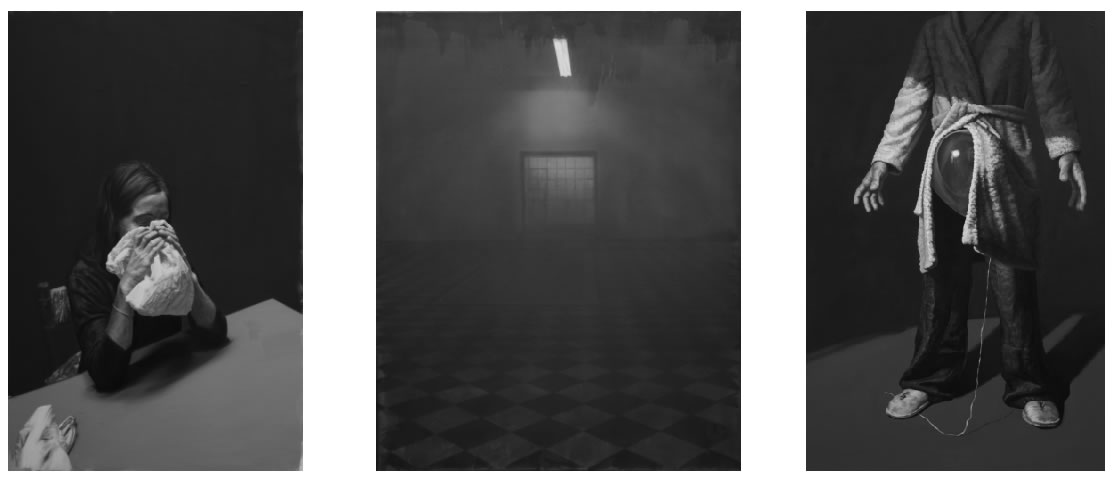
左からQuarry Diego Cirulli 2016 Oil on canvas / Hollow Diego Cirulli 2016 Acrylic on canvas / Be Formed Diego Cirulli 2016 Oil on canvas
about Diego Cirulli
ディエゴ・シルリについて
ディエゴ・シルリは、1981年、アルゼンチン・リオネグロ州バリローチェに生まれ、現在はブエノスアイレスを拠点に活動している。今日までにアート作品を通じて、歴史的・政治的な社会問題に焦点を当て、ペインティング制作を続けてきた。中でも貧富の差や子供、ジェンダーの問題、そして彼の母国の近年の歴史と現在に至る複雑な有り様に重きを置いた作品制作をしている。 その傍らで、世界三大劇場の一つとして名高いオペラ劇場「テアトロ・コロン」の舞台美術に置いてステージ・プロデューサーを務め、また、自身のアートワークショップ「Kalos」ではディレクター及び美術・美術史のクラスの講師として活動するなど、多方面に渡り表現の場を広げている。2012年に開催されたブエノスアイレスの文化センターでの個展「21-105 記憶空間の意義と再定義」や、インスタレーション作品「Porosity」は、とても興味深く、自身にとっても重要な展示だったという。
Diego Cirulli was born in 1981 in Bariloche, Río Negro, Argentina and is currently based in Buenos Aires. In his art work he focuses on historical and political issues of society through painting. He particularly deals with matters like the disparity of wealth, issues of gender and youth, and the complexities of his country’s present, and its recent past.
In addition, he is also a stage producer in the scenography department of the ‘Teatro Colón’ which is one of the three major opera companies in the world. He expands and crosses into new fields of work, including ‘Kalos’, his own workshop, where he works both as a director and as an art/art history instructor. His 2012 solo show 21-105 significance and redefinition of Memory Spaces at the Haroldo Conti Memory Cultural Center in Buenos Aires, and his installation Porosity are intriguing, and are works that he himself regards as important.
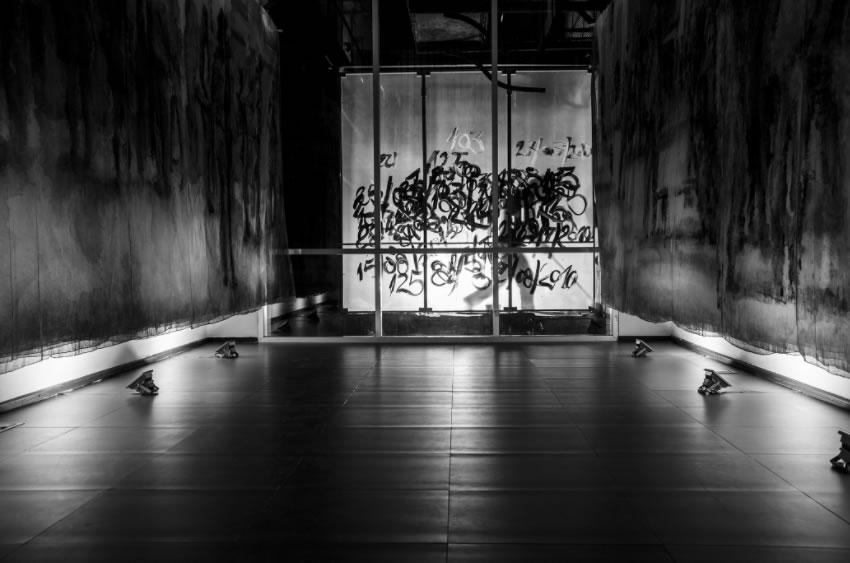
“Porosity”
Contemporary Art Space EAC(Montevideo,Uruguay)2013
歴史ある元刑務所、現在アートスペースとして開放する場で開催。過去から現在を感覚的なレイヤーで繋ぎ、その時間軸を接近させることを目的としたインスタレーション。
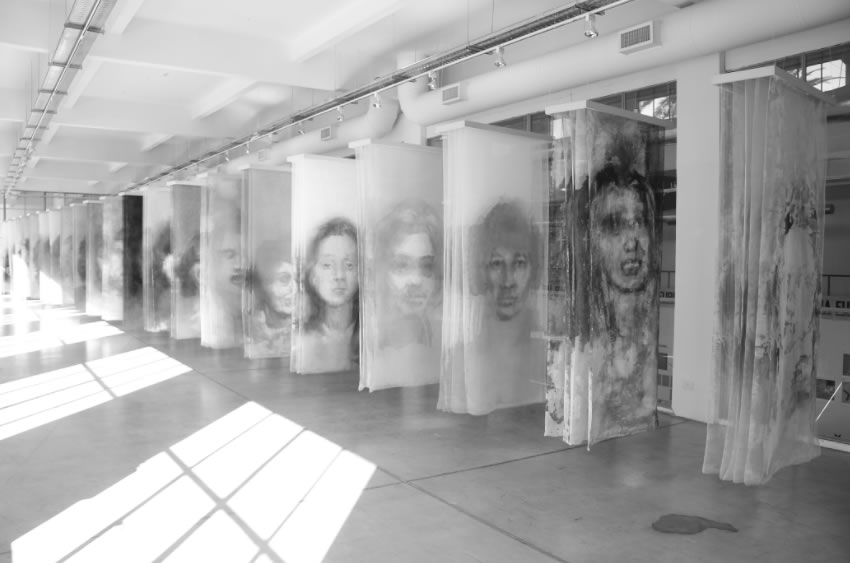
“21-105”
Cultual Center of Memory of Haroldo Conti(Buenos Aires,Argentina)2012
アルゼンチン独裁政権下の秘密機関に囚われた女性たちのポートレートを描いたインスタレーション。
Questions for Diego Cirulli
東京で展覧会を開催する話があった時、率直にどう思いましたか? また、日本に対するイメージなどはありますか。
日本という国とその歴史にはずっと興味を持っていました。日本がつくり出すイメージと、それらが西洋で翻訳や変換されてできたものを手に取ってみると、つぎはぎで断片的になったものが多く、伝統と前衛、版画とアニメ、漫画と哲学、空虚と俳句、美と罪などが同時に存在しています。日本を訪れることでそういった表象に体と道を与え、私自身の国の歴史に対する想像を広げ、再構築するものになり得るのではないかと思います。
今回のプロジェクトはどのようにして始まったのですか?
ドローイングが『Thickness of Silence』を思考するプロセスの始まりでした。具体的なテーマを決めずに、未知なるものに姿を与えるための構築や、あるいは意図的にその調和を壊す脱構築の中で形やテクスチャーと出会う機会であり、同時に創作手段が持つある種の問題と向き合う時間でもありました。ペインティングが始まると予想通り、それまでのコンセプトを違う手法に持ち込むことに、困難、時には不可能と思える場面もありました。説明することと仄めかすことの違いや表象と存在の差についてはいくらでも話すことができます。しかしそう言ったカテゴリーに言葉を放り込む以前に、私が興味を持っているのは、根本的にペインティングは色のついた物質をかき混ぜるという作業であり、それに対してドローイングは紙を引っ掻いて線と明暗を生み出す行為なのだ、と認識することにあります。絵具をかき混ぜるという営みには何よりも惹きつけられます。私たちが歩む日常にも、何か似たような性質のものが存在する可能性を考えさせられるのです。
あなたは絵を発表する傍ら劇場のスタッフとしても活動していますが、それぞれどのようなモチベーションで行なっていますか?あなたの哲学、また、作品制作におけるインスピレーションを教えてください。影響を受けた画家やアーティストはいますか?
「影響」について語るときに考えたいのは、アートの分野に限らずもっと広大な領域で経験する、私が心惹かれたアート作品の数々を糸で繋ぐようなもの、そして私の思考の中に入ってきたすべてのものについてです。ペインティングや芸術分野と言ったカテゴリーに収まらないもの、つまり文学や音楽などにも視野を広げるということだけにとどまらず、様々な経験の断片、匂いや色、味などが記憶の中に散らばり、やがてそれらがアーティスティックな行為によってひとつに繋がれ、意味を持ちだそうとすることが「影響」です。これは意味が先にそれ自体で存在しているのではなく、影響を及ぼした他の全てのものと共に、表象をつくりだすという行為の要素として構成される、ということです。
ここでボルヘスのオリジナリティーに関する考察を引用することもできますし、カフカの言う、思考されるものに明らかな出発点があるのではなく、全ては中途のどこかから始まっているということを語ることもできます。または私自身の人生で舞台美術やステージ・プロデューサーとしての活動など、物質的、また経験的に影響を受けたものごとを列挙することもできます。
そういった事柄はみな互いに補い合うものなのです。私が言おうとしているのは、私たちの周りにある全てのもの、バルテュスの絵画であろうが萎れた花であろうが渋滞する高速であろうが、それらは全て作品の中で消化され、創作活動の中で意味を生み出す可能性を秘めている、ということです。そういった創作活動は知的かつ感情的な働きかけであり、生身の勘と、作品を纏めテリトリーをあらわにする糸が必要です。
明確な根源を持っている要素の、その根源の地を壊すことで、その要素は新しい表象の構造の中で機能し始めるのです。みずから形や反影といったものから育っていく創作作品は表象の深みに向かわなくてはならない。表象が表象たらしめる機構の中へ、新しい形、新しい意味、そして新しい表層 – 意味を掴んだと思うが否やその手をすり抜ける表層 – の方へ。創作において大切なのはその点です。それが我々の認識を揺さぶり、軋轢の中に放り込むからです。私たちが見つめる自身の顔を見知らぬ国のそれに変え、私たちを残していく。常に私たちの視線を捉えて離さない領域に。廃墟となった風景を目の当たりにしたときの震えるほどの衝撃に。
そしてその風景の背後、裂け目の中に引きずられていく空虚な地に。絵画の力は、確立された関係性において何かが偶発する可能性をアーティストに呼び起こします。平凡な日常を、その日常の中に在りながらかき乱したいという欲求もあるかも知れません。そうでなければ不合理な表象の中に落ちていってしまうかも知れないのです。その点で「影響」は重要で、それがあってこそ私たちが起こす偶発に作用し、フランシス・ベーコンの言うように例えば画家が絵を描き、また音楽家が曲を作るための「技術的想像」によって出来た、個人的システムという名の泥から抜け出すことができるのです。
What were your honest feelings when you heard about having a show in Tokyo? What impression do you have of Japan?
Japan and its history have always drawn my attention. The images and the translations and interpretations available in the West that reached my hands are eclectic and fragmented, composed both of tradition and avant-garde, etchings and anime, manga and Tao, emptiness and haiku, beauty and transgression. Traveling to Japan is a possibility for me to give those images a body and a path, to widen and reformulate the suppositions I constructed in my own history.
How did you start the project?
Drawing is where the imaginary process of Thickness of Silence started. It was a search for shapes and textures without a concrete objective, in the adjustments and disadjustments of giving a form to something that is still unknown, dealing at the same time with the specific difficulties of the medium. When that was taken over to painting, as can be expected, there was a certain impossibility, or difficulty, in the translation. We could speak about the differences between the illustrative and the evocative, or between representation and presence, but before plunging into those categories, I would be interested in underlining that the operation of painting is based on stirring colored matter, while drawing consists of scratching paper in order to generate lines and values. The action of stirring paint is what draws me in today more than ever. It invites potencies of similar natures to revolve the way we walk through our everyday lives.
At the same time as painting, you also work in theater production. What is your motivation in each area?
What is your philosophy, and your inspiration, for creating art? Is there any artist or painter who influenced you?
When talking about influences, I would like to point toward a broader frame than just the art scene, in an extensive exercise of threading together the works of art that draw my attention, and every thing that my attention is captivated by. It is not only about broadening the perspective to include works made in materials different from painting or outside the field of art, as would be the case for literature or music, but also to include clusters of experience, smells, colors, flavors that are dispersed in memory and are threaded together in the artistic act and become an attempt of producing meaning. This does not mean that meaning exists previously by itself, but is instead constituted in the very act of creating an image, along with everything that influenced that act. I could here quote Borges and his thoughts on originality, or perhaps paraphrase Kafka when he says that the things he comes up with do not present themselves in their roots, but start at any point in the middle.
I could enumerate the elements in my own history that influenced me materially and experientially, bound for example to the world of theater and my work as a scenography producer. These are fields that feed back into one another. What I am attempting to put into words is that everything that cuts across us, whether it is a painting by Balthus, a withered flower or a highway crammed with cars, can be put to work in a creative operation that may produce images. Setting this in motion is an intellectual and affective commitment, which involves a bodily kind of intuition, finding the stitches of the thread that unites the work and delineates a territory. These elements have distinct origins and, deterritorializing them, we may put them to work within new symbolic mechanisms.
A creative work that nurtures itself from shapes and influences is necessarily directed toward the depth of the image, toward the machinery that generates it, toward the potencies that become new shapes, new meanings, new surfaces that escape us as soon as when we think that we have grasped them.
This is an important point in every image, what shakes up our understanding and puts us in a state of estrangement, turning us into foreigners facing our own image, placing us in a territory that ceaselessly captivates our sight, the vibrating astonishment of witnessing a landscape in ruins and the clearing that draws itself behind it, between the cracks.
That potency of the image is played out, for its creator, in a known field of interaction, in the contingency of possibilities. There must be a desire to shake up the quotidian, but within the quotidian itself. Otherwise, there is a risk of falling into absurd pretension. Therein lies the importance of influences, as that which affects us in our contingency and leads us to pull out from the soil of our own personal systems, as Francis Bacon said, with the technical imagination of a painter when painting, or a musician’s when making music.
・The Thickness of Silence・
シルリは約一年間の制作時間を当て104 GALERIEでの展示に挑んでくれる。少し前に送られてきたタイトルは”The Thickness of Silence”(日本語で『沈黙の密度』)、という彼らしいタイトルだった。
その作品群は異質で、女性なのか男性なのか、人間なのかモンスターなのか決して断定することのできないイメージに、魅惑的な謎と特異性がたくさん詰められている。この奇妙な夢のようでもあるシルリのインスピレーションは、私たちに馴染みのある世界だとも捉えられるし、別世界か時代を超えた新しい世界のようだとも捉えられる。そしてこの理解しにくい現実は私たちを魅了し誘う。これらの表象は一体何なのか。私たちは認識しようとするが、最終的にはその正体は未知のまま完全に解読することはできない。彼の作品の最大の魅力はそこにあると思う。
Cirulli spent almost a year preparing his exhibition at 104GALERIE. The show title I received – The Thicknessof Silence – was, I thought, very Cirulli-esque.
This collection of work is other worldly ; in the unident if iable images of women or men , humans or monsters , there arefas cinating my steries and peculiarities. It is like a bizarre dream, which could be inspired by our familiar world or some kind of parallel, or time-transcending, new world.
This in definable reality charms us, and induces us to question what these are representations of. We try to recognize elements, but inthe end its truth remains unknown, never to befully understood. That is the most potent charm of his work.
「深淵を覗き込むとき、深淵もまたこちら側を覗き込んでいるのだ。 フリードリッヒ・ニーチェ」
今や絵画の前では、恐らく一心に黙し、留まるほかないのだ。動きのなかに、回転のなかに、漂い混ざりゆくなかに留まり続ける。表象は複数の顔を持ち、その顔たちを見定めようとする間もなく次々に姿を変え、やがてかたちすら消え去り、亀裂のなかから、鼓動する場から、弛緩と収縮を繰り返す身体から我々を見返している。
– 顔のない、主体。
世界を理解する術を放棄し、放浪する流れに身をゆだね、あらゆる物質の攪拌と砕け散った言葉と眼窩をなくした目が生み出す吐き気のなかに、虚空の裂け目になる。あるいは濃密な深淵をひたすら見つめてはいるものの、それを知覚できるのは指先だけだ。絵画を前にして残された選択肢は、この現象を受容するほかにない。その絵にひそむ幾つもの顔たちは創造の空間に宿り、顔たちを凝視するその瞳をじっと見返している。
ここに集められた作品は自己概念が自らを破滅に至らしめる行為を、途切れとぎれの葬送曲のように、死の儀式と出生の剥き出しの身体性にいざなう。そしてそれは我々が自身をある種の事象として認識する場となる。そこではすべてのものが朽ち果て、すべてが新しいのだ。
ディエゴ・シルリ
The Thickness of Silence
“If thou gaze long into an abyss, the abyss will also gaze into thee.” Friedrich Nietzsche. Perhaps, the most sincere act before painting today is to be silent and remain. To remain in motion, in rotation, in wandering permeability. Aspiring to the multiple in that which we look at; that which is fleeting , changing and formless, that which looks back at us from the cleft, pulsating worlds,
tensating bodies; an identity without a face.
Losing g rasp of what is supposed, finding drif t paths and inhabiting the nausea of agitated materiality, the dissolved word, the unmounted eye, becoming the cleft. Or staring into the thickness of the void that only our fingertips allow us to know.
What remains is to acknowledge the event before painting , the collective surrender of the multiple within the image, which subsists in that created space and observes us looking at it.
This collection of works invites, in discontinuous fugues, to the ritual of death and the convolution of birth, the suicidal act of our own image. To acknowledge ourselves as an event. There, where everything withers
Diego Cirulli
今回の展示はペインティング約20枚にドローイング10枚、彫刻作品にVR作品と様々な方法で展覧できる内容となる予定だ。また、オープニングレセプションでは、以前「dictionary #173-174」の“paper show”でも登場しているアートディレクターの永戸鉄也とシルリのトークショーも開催する。
わたしがいつもこの仕事をしていて思うことは、アーティストはいつも絵や作品を通して決して他には変えられない複雑で入り混じった感情のプレゼントをくれる。その絵に触れ、視界に入れることによってどんどん自分の中にその絵の持つ力がはいってくる。時にはロマンティックな夢の旅をさせてくれる、時には深く思考しなさいと問いかける。たった一枚の小さなキャンバスに、個々が自由に様々な思いを馳せることができる。その絵を所有した時にはきっと、何年も何年も掛けて絵と対話し、新たな答えや感情と共にその人にとって必要不可欠な唯一無二の宝物になるんだと思う。ディエゴ・シルリは今回私たちにどのようなプレゼントをくれるのだろう。私はそれが今から楽しみでしょうがない。そしてまた一つ、この展覧会が私の原動力になるのは間違いないだろう。
This show will consist of approximately 20 paintings and 10 drawings, sculptures, and a VR-piece, developing a range of differing perspectives. At the opening reception, a talkshow will be held with Cirulli and Tetsuya Nagato, whose“ paper show” was featured in“ dictionary #173-174”
As a gallery curator, artists often give me the gift of complex emotions that are inexpressible through means other than their painting, or their work. By inhabiting the space of a painting, and having it within my vision, the power of the work flows into me. Sometimes it allows me to travel on romantic dream journeys, and sometimes it asks me to think deeper. A small canvas creates enough space for individuals to let their minds wander. And when a work is bought, the owner can communicate and live with it through the years. It is an irreplaceable treasure, in which new answers and emotions grow. I wonder what gift Cirulli is going to give us, and I am looking forward to seeing it. And without a doubt, this show will provide me with a new power and motivation to take into the future.
Diego Cirulli
会期:2017 年10月7日(土) – 12月10日(日)
オープニングレセプション:10月7日(土) 18:00 -21:30
ディエゴ・シルリ×永戸鉄也のトークショー
営業時間:12:00-20:00
休廊日:水曜日、10月16日~20日休廊
会場1:104GALERIE 東京都目黒区青葉台3-22-1 目黒ハイツ104
会場2:104GALERIE-R 東京都目黒区大橋1-6-4
協力:BC Gallery (www.bcgallery.de)
問い合わせ先:+81 (0)3 6303 0956
info@104galerie.com
www.104galerie.com
